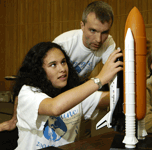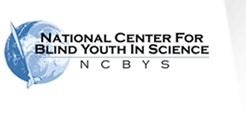Make a Gift to the NFB Jernigan Institute Contact Us Site Map
National Federation of the Blind
Junior Science Academy
The NFB Jernigan Institute developed its annual Science Academy to spark and enhance blind students' interest in scientific study, an academic area that many falsely believe is too difficult for the blind. By providing hands-on experiences and tactile materials, the Academy is a prime example of how to use nonvisual teaching methods and blind role models in the classroom to engage blind youth in the study of science and math.
The Science Academy, broken down into two sessions, was first held in July and August of 2004. Due to their successful demonstration that blind youth can compete in challenging science related activities, the NFB has continued its commitment to operate this outstanding Academy.
The Circle of Life session is targeted at blind middle school students and is focused around the earth and life sciences. The goal of this session is to spark an interest in science and to introduce the students to blind role models working in the field. The students take part in various activities, such as exploring the Chesapeake Bay and its watershed, learning about chemistry and electronics, and dissecting a dogfish shark.
 The Rocket On! session is for blind high school students and focuses on physics, electronics, rocketry, and teamwork. In this session, the participants work closely together in teams to build a rocket payload, make trajectory predictions, prepare the rocket for launch, and execute the other critical elements of a real NASA rocket mission. The goal of this session is to increase interest and support possible careers in the sciences. This session pushes students beyond simply--wanting--to go into science and launches them into the relm of--believing-- they can by having them independently execute tasks they would have never imagined possible. The first NFB Rocket Team successfully launched their rocket from the Wallops Flight Facility in Virginia on August 19, 2004. The second NFB Rocket Team followed in their footsteps with a launch on July 21, 2005.
The Rocket On! session is for blind high school students and focuses on physics, electronics, rocketry, and teamwork. In this session, the participants work closely together in teams to build a rocket payload, make trajectory predictions, prepare the rocket for launch, and execute the other critical elements of a real NASA rocket mission. The goal of this session is to increase interest and support possible careers in the sciences. This session pushes students beyond simply--wanting--to go into science and launches them into the relm of--believing-- they can by having them independently execute tasks they would have never imagined possible. The first NFB Rocket Team successfully launched their rocket from the Wallops Flight Facility in Virginia on August 19, 2004. The second NFB Rocket Team followed in their footsteps with a launch on July 21, 2005.
On July 19, 2006, the most recent Rocket On! team successfully launched their rocket at 6:00 a.m. They also had successful parachute deployment and recovery, and the rocket returned to the Jernigan Institute on July 20. On July 21, the group held a press conference at the Jernigan Institute to discuss their mission. The 2006 Circle of Life session of the Academy was July 29-August 5. The students had a very busy week, traveling to the Maryland Science Center, the Goddard Space Flight Center, and the SERC center. The participants also had the opportunity to explore the Chesapeake Bay on a work boat and dissect a dogfish shark.
In 2010, the Jernigan Institute will host the Junior Science Academy and open its doors to the youngest group of scientific explorers thus far, targeting children in grades three through six. With hands-on experiences, tactile materials, and innovative nonvisual teaching methods, the Academy will expand on its past success to bring the excitement of science to these young students. In addition, the Academy will have corresponding parent workshops to provide parents/guardians with the tools and knowledge that they need to help their child succeed.
Learn more about the Science Academy:
2008 Junior Science Academy
Impact of the Academy on the students
Articles:
"Rocket Launch a First for Visually Impaired Girl," The Indianapolis Star
"Rocket Science a Blast for Blind Kane'ohe Teen," The Honolulu Advertiser
"Rocket On! Excitement, Challenge, and Growth," Braille Monitor
"The 2004 NFB Science Academy: Turning Dreams into Reality," Braille Monitor
"Blind Students Are Rocket Scientists," NASA
The majority of funding for the 2006 NFB Science Academy came directly from the National Federation of the Blind. Our deepest appreciation goes to the other supporters of the 2006 Academy, including:
American Action Fund
Lockheed Martin Foundation
Northrop Grumman Corporation
Coca Cola Foundation
M & T Bank
Additionally, we want to thank our other participating partners for their commitment to our program:
NASA Goddard Space Flight Center
Maryland Science Center
The Whiting School of Engineering at Johns Hopkins University


